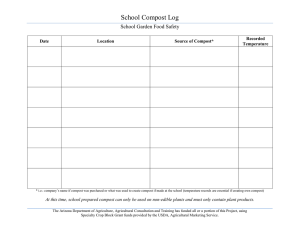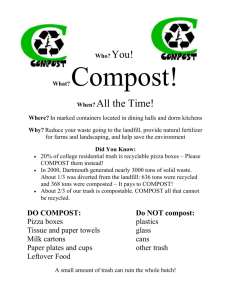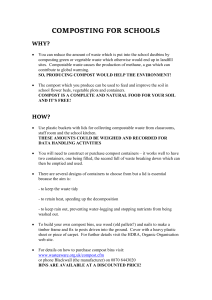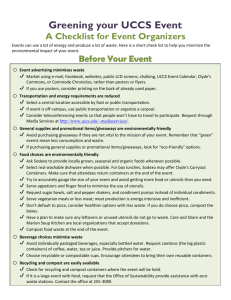Start Gardening Series 5 Container Gardening
advertisement
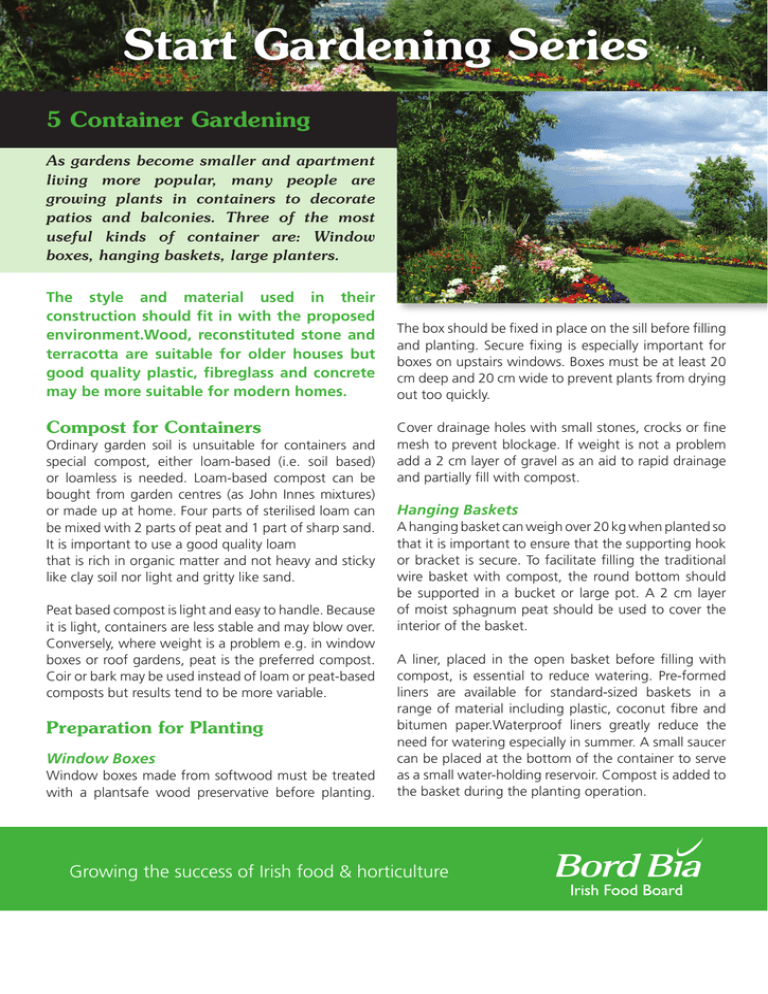
Start Gardening Series 5 Container Gardening As gardens become smaller and apartment living more popular, many people are growing plants in containers to decorate patios and balconies. Three of the most useful kinds of container are: Window boxes, hanging baskets, large planters. The style and material used in their construction should fit in with the proposed environment.Wood, reconstituted stone and terracotta are suitable for older houses but good quality plastic, fibreglass and concrete may be more suitable for modern homes. Compost for Containers Ordinary garden soil is unsuitable for containers and special compost, either loam-based (i.e. soil based) or loamless is needed. Loam-based compost can be bought from garden centres (as John Innes mixtures) or made up at home. Four parts of sterilised loam can be mixed with 2 parts of peat and 1 part of sharp sand. It is important to use a good quality loam that is rich in organic matter and not heavy and sticky like clay soil nor light and gritty like sand. Peat based compost is light and easy to handle. Because it is light, containers are less stable and may blow over. Conversely, where weight is a problem e.g. in window boxes or roof gardens, peat is the preferred compost. Coir or bark may be used instead of loam or peat-based composts but results tend to be more variable. Preparation for Planting Window Boxes Window boxes made from softwood must be treated with a plantsafe wood preservative before planting. The box should be fixed in place on the sill before filling and planting. Secure fixing is especially important for boxes on upstairs windows. Boxes must be at least 20 cm deep and 20 cm wide to prevent plants from drying out too quickly. Cover drainage holes with small stones, crocks or fine mesh to prevent blockage. If weight is not a problem add a 2 cm layer of gravel as an aid to rapid drainage and partially fill with compost. Hanging Baskets A hanging basket can weigh over 20 kg when planted so that it is important to ensure that the supporting hook or bracket is secure. To facilitate filling the traditional wire basket with compost, the round bottom should be supported in a bucket or large pot. A 2 cm layer of moist sphagnum peat should be used to cover the interior of the basket. A liner, placed in the open basket before filling with compost, is essential to reduce watering. Pre-formed liners are available for standard-sized baskets in a range of material including plastic, coconut fibre and bitumen paper.Waterproof liners greatly reduce the need for watering especially in summer. A small saucer can be placed at the bottom of the container to serve as a small water-holding reservoir. Compost is added to the basket during the planting operation. Growing the success of Irish food & horticulture Start Gardening Series 5 Container Gardening Large Containers If large pots, troughs or barrels are used, these should be slightly raised above the ground using small blocks or bricks. This aids free drainage, prolongs the life of wooden containers and reduces the risk of entry of soil pests. Place a five cm layer of small stones or broken brick at the base of the container to aid drainage and top up with compost. Plants for Containers Window Boxes A wide range of plants can be used including pansies (for winter colour), dwarf bulbs (for spring), annuals and perennials such as pelargonium (for summer) and dwarf shrubs (for permanent planting). Plants should be selected carefully so that they can be seen from inside the house but will not be so tall that they block out light. An example of a planting scheme for a 1 metre long x 25 cm wide window box would be 2 trailing ivy (one at each end), a row of 7 surfina petunia at the front and 2 grey helichrysum towards the back. Hanging Baskets Many different kinds of plants can be used but the most popular are summer flowering bedding plants, such as pelargonium, petunia, fuchsia and impatiens. A 45 cm (18 in.) diameter basket could be planted up with one fuchsia ‘Swingtime’ or ‘Cascade’, 8 plants of lobelia ‘Cambridge Blue’ and 3 plants of Helichrysum petiolare. The basket should be planted as follows: Put one third of the compost in the basket and plant 3 lobelia at this level by cutting appropriate holes in the liner and pushing the roots carefully through the wire-mesh so the top growth of the lobelia is trailing on the outside. Add a further third of the compost and plant 2 lobelia and 3 helichrysum at this level in the same way. Fill in the remainder of the compost and plant the fuchsia in the middle of the container and surround it with the remaining 3 lobelia planted on the top surface of the compost. As with other containers, the level of the compost should be about 2.5 cm below the rim to allow for watering. Large Containers Many plants can be grown in large containers including those mentioned for window boxes and hanging baskets. Most suitable plants are generally those with a bushy habit such as pelargonium, calceolaria, begonia and fuchsia with trailers around the edge to soften the sides of the container. Perennial plants such as heather, ivy, Japanese maple and camellia can be grown successfully in large containers. Care Watering needs to be done carefully as it is easy to overwater or underwater plants where their rootrun is restricted. Containers should never be allowed to dry out completely, nor should the plants be kept constantly moist. However, a well-filled hanging basket in summer will dry out quickly and may need watering twice a day. Because their root system is constricted, plants in containers need regular feeding. Many kinds of slow release fertilisers for adding to compost and foliar feeds are available. Removing the dead flower heads will prolong their flowering period and improve their appearance. Your local garden centre can supply suitable containers, compost and plants as well as providing additional information on how to get best results. Growing the success of Irish food & horticulture


